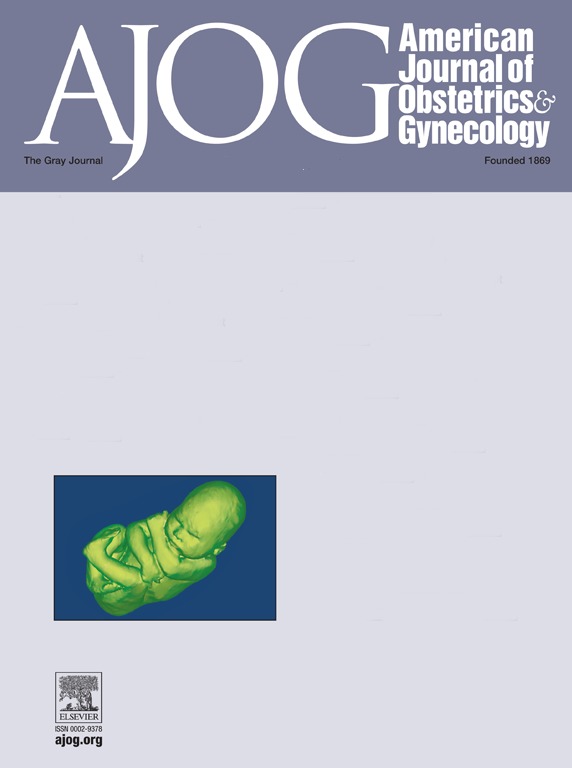Small for Gestational Age sub-groups have differential morbidity, growth and neurodevelopment at age 2: the INTERBIO-21st Newborn Study.
IF 8.7
1区 医学
Q1 OBSTETRICS & GYNECOLOGY
引用次数: 0
Abstract
BACKGROUND Small for Gestational Age (SGA) is a complex perinatal syndrome associated with increased neonatal morbidity, mortality, and impaired childhood growth and neurodevelopment. Current classifications rely primarily on birth weight, which does not capture the heterogeneity of the condition nor predict long-term health outcomes. Here we aim to identify and characterise distinct SGA sub-groups and assess their neonatal and early childhood health trajectories. OBJECTIVES To refine the classification of SGA by identifying sub-groups based on maternal, fetal, and environmental factors and evaluating their associations with neonatal morbidity, growth, and neurodevelopment at age 2. STUDY DESIGN Prospective Cohort Study. In six countries worldwide, between 2012 and 2018, the INTERBIO-21st Study enrolled SGA and non-SGA newborns defined by the <10th centile of international standards with moderate (≥3rd to <10th centile) and severe (<3rd centile) SGA sub-groups; we assessed their growth, health, nutrition, motor development, and neurodevelopment up to age 2. We used 2-step cluster analysis to identify SGA sub-groups, and a probabilistic approach to choose the optimal sub-group model based on a statistical measure of fit. We performed logistic regression analysis (OR; 95% CI) to assess health and development outcomes among sub-groups using the non-SGA as reference group, adjusting for key confounders. RESULTS We enrolled 5153 non-SGA and 1549 SGA newborns: moderate (≥3rd to <10th centile) SGA=947 and severe (<3rd centile) SGA=602). We identified nine SGA sub-groups: 'no main condition detected' (29.0%); 'previous low birth weight (LBW)/preterm birth (PTB)' (14.6%); 'severe maternal disease' (12.0%); 'maternal short stature (11.6%); 'hypertensive disorders' (9.6%); 'extrauterine infection' (6.8%); 'previous miscarriage(s)' (6.5%); 'smoking' (5.2%), and 'maternal under-nutrition' (4.7%). Severe SGA newborns in the 'severe maternal disease' (OR: 3.2; 95% CI, 1.8-6.0), 'previous LBW/PTB' (OR: 2.8; 95% CI, 1.6-4.8), and 'smoking' (OR: 5.4; 95% CI, 1.3-21.8) sub-groups had increased risk of neonatal and long-term morbidity, and low anthropometric measures at age 2 as compared to the non-SGA group. Moderate SGA newborns in the "hypertensive disorders" sub-group had increased risk of neonatal morbidity (OR: 2.6; 95% CI, 1.5-4.6), and higher odds of scoring <10th centile of normative values in language (OR: 3.5; 95%CI, 1.0-12.0) and positive behavior (OR: 2.2; 95%CI, 1.1-4.5). The 'severe maternal disease' sub-group had also higher risk of deficit (<10th centile of normative values) in language (OR: 5.7; 95%CI, 1.3-24.8), positive behavior (OR: 3.4; 95%CI, 1.5-7.6). CONCLUSIONS SGA comprises heterogeneous sub-groups with distinct patterns of neonatal morbidity, postnatal growth, and neurodevelopmental outcomes up to age 2.小胎龄亚组在2岁时有不同的发病率、生长和神经发育:interbio -21新生儿研究。
背景:胎龄小(SGA)是一种复杂的围产期综合征,与新生儿发病率、死亡率增加、儿童生长和神经发育受损有关。目前的分类主要依赖于出生体重,这不能反映疾病的异质性,也不能预测长期的健康结果。在这里,我们的目标是确定和特征不同的SGA亚组,并评估他们的新生儿和幼儿健康轨迹。目的:根据母体、胎儿和环境因素确定SGA亚群,并评估其与2岁新生儿发病率、生长和神经发育的关系,从而完善SGA的分类。研究设计前瞻性队列研究。在2012年至2018年期间,interbio -21研究在全球6个国家招募了SGA和非SGA新生儿,其定义为中度(≥第3至<第10百分位)和重度(<第3百分位)SGA亚组;我们评估了他们的生长、健康、营养、运动发育和神经发育,直到2岁。我们使用两步聚类分析来识别SGA子组,并基于统计拟合度量采用概率方法选择最优子组模型。我们进行了逻辑回归分析(OR;95% CI),以非sga为参照组,对关键混杂因素进行调整,评估亚组的健康和发展结果。结果纳入5153例非SGA新生儿和1549例SGA新生儿:中度(≥3 - <10百分位)SGA=947例,重度(<3百分位)SGA=602例。我们确定了9个SGA亚组:“未检测到主要疾病”(29.0%);“既往低出生体重(LBW)/早产(PTB)”(14.6%);“严重孕产妇疾病” (12.0%);母亲身材矮小(11.6%);“高血压疾病”(9.6%);“子宫外感染”(6.8%);“曾经流产”(6.5%);“吸烟”(5.2%)和“产妇营养不良”(4.7%)。严重SGA新生儿的“严重孕产妇疾病”(OR: 3.2;95% CI, 1.8-6.0),“既往LBW/PTB”(OR: 2.8;95% CI, 1.6-4.8)和“吸烟”(OR: 5.4;95% CI, 1.3-21.8)亚组与非sga组相比,新生儿和长期发病率的风险增加,2岁时人体测量值较低。中度SGA“高血压疾病”亚组新生儿发病风险增加(OR: 2.6;95% CI, 1.5-4.6),并且在语言中得分<10百分位标准值的几率更高(OR: 3.5;95%CI, 1.0-12.0)和积极行为(OR: 2.2;95%可信区间,1.1 - -4.5)。“严重产妇疾病”亚组的语言缺陷风险也较高(<标准值的第10百分位)(OR: 5.7;95%CI, 1.3-24.8),积极行为(OR: 3.4;95%可信区间,1.5 - -7.6)。结论ssga包括异质性亚组,具有不同的新生儿发病率、出生后生长和2岁前神经发育结局模式。
本文章由计算机程序翻译,如有差异,请以英文原文为准。
求助全文
约1分钟内获得全文
求助全文
来源期刊
CiteScore
15.90
自引率
7.10%
发文量
2237
审稿时长
47 days
期刊介绍:
The American Journal of Obstetrics and Gynecology, known as "The Gray Journal," covers the entire spectrum of Obstetrics and Gynecology. It aims to publish original research (clinical and translational), reviews, opinions, video clips, podcasts, and interviews that contribute to understanding health and disease and have the potential to impact the practice of women's healthcare.
Focus Areas:
Diagnosis, Treatment, Prediction, and Prevention: The journal focuses on research related to the diagnosis, treatment, prediction, and prevention of obstetrical and gynecological disorders.
Biology of Reproduction: AJOG publishes work on the biology of reproduction, including studies on reproductive physiology and mechanisms of obstetrical and gynecological diseases.
Content Types:
Original Research: Clinical and translational research articles.
Reviews: Comprehensive reviews providing insights into various aspects of obstetrics and gynecology.
Opinions: Perspectives and opinions on important topics in the field.
Multimedia Content: Video clips, podcasts, and interviews.
Peer Review Process:
All submissions undergo a rigorous peer review process to ensure quality and relevance to the field of obstetrics and gynecology.

 求助内容:
求助内容: 应助结果提醒方式:
应助结果提醒方式:


